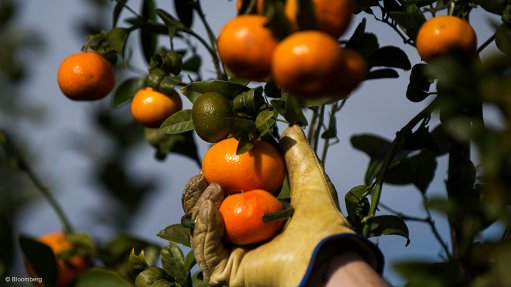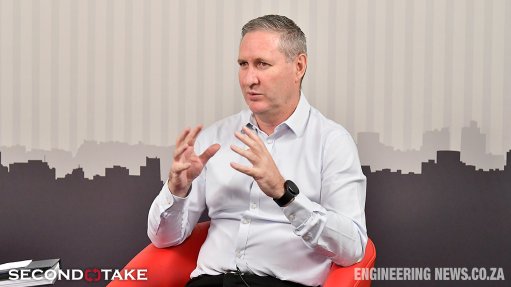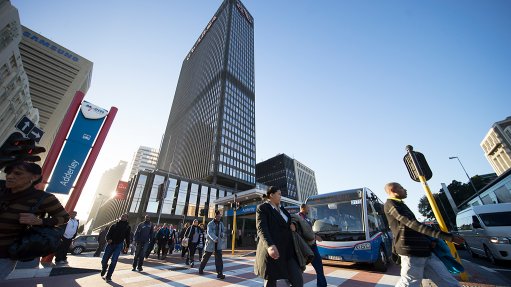Uranium, diamonds present potential amid challenges
The biggest potential for growth in the Namibian mining industry is uranium, notes professional services firm KPMG Namibia senior partner Robert Grant, highlighting that the country is facing tough economic conditions in addition to the impact of a drought.
He tells Mining Weekly that this growth depends on two factors. The first is an increase in the price of uranium. The spot price of uranium in January was $24.50/lb, down on January 2015’s price, when it traded at $34.70/lb, according to the website of one of the world’s largest uranium producers, Cameco.
The second growth driver is the future increase in production from new mines coming on stream.
The country’s main uranium contenders include British-Australian multinational metals company Rio Tinto, which owns the Rössing uranium mine, in the Namib desert, and uranium production company Paladin Energy’s Langer Heinrich mine, in the western Namibia.
However, it is major energy corporation China General Nuclear Power Group’s Husab uranium project, in western-central Namibia, which will start production this year and ramp up to full capacity by next year, that is expected to make the most impact. Grant says this project is expected to push Namibia from being the world’s fourth- or fifth-largest uranium producer to the third-biggest producer.
Research analysis group BMI corroborated this notion in a December statement, noting that Namibia’s economic growth is expected to pick up substantially in 2017 as the Husab uranium mine starts production, making the country one of the world’s largest uranium producers.
The mine, which is reported to be the third-largest uranium mine in the world, will come on line in the first half of 2017, boosting Namibia’s domestic uranium production from 2 900 t in 2016 to 5 800 t this year.
“We expect uranium to become a key driver of Namibian exports over the next several years. We forecast real export growth of 7% in 2017, compared with 2.1% [in] 2016,” BMI said in its statement.
Diamonds
Grant explains that diamonds are also a significant contributor to Namibia’s economy, but, in the past few years, production has declined, largely owing to reduced demand.
However, the Namibian government, which is a 50% shareholder in Namdeb, a joint venture with diamond mining giant De Beers, has pinned its sights on marine diamonds.
He highlights that diamond miner Debmarine, wholly owned by Namdeb, bought a new diamond exploration and sampling vessel, the SS Nujoma, which arrived at the coast of Namibia late last year to join a fleet of five diamond mining vessels.
UK-based newspaper The Telegraph reported in September 2016 that Namdeb expected that 95% of its diamonds would in future come from the seabed off Africa’s south-west coast, with marine gems already fetching the highest prices of all its seven mining operations.
Namibia’s Atlantic coast area holds an estimated 80-million carats of gems, the world’s richest marine diamond deposits, which were carried to the sea by the Orange river and could be mined beyond 2050, says De Beers.
Challenges
Mining makes a big contribution to Namibia’s gross domestic product, employs quite a number of people and contributes a significant amount to the fiscus through taxes and foreign direct investment, says Grant.
However, many mining companies in Namibia are facing difficulties, largely owing to the country’s economic conditions and flat commodity prices, as well as the depreciation of the Namibian dollar because of its link to the rand and South Africa’s unstable economic and political climate.Miners are also dealing with Namibia’s severe lack of skills, which is driven by its small population and the bulk of its skills base being in Windhoek, while mines are located across the country in remote areas, far from the capital.
It is difficult to bring skilled workers into the country, given the vigorous work permit requirements for foreigners and the limited number of expatriates who are allowed entry.
The Namibian mining industry is also facing legislative uncertainty regarding the Namibia Investment Promotion Act, which Grant says has raised many questions among investors and industry players because of its grey areas.
The purpose of the Act is to promote sustainable economic development and growth through the mobilisation and attraction of foreign and domestic investment to enhance economic development, reduce unemployment, accelerate growth and diversify the economy. However, the implementation of the Act has yet to be completed.
Detailing concerns about the Act in a presentation dated October 2016, Grant stated that the time and money needed for the approval of investment might dissuade foreign investors, while the expansion of existing businesses which carry foreign investment is subject to the Act, which has implications for growth.
Further, the industry has been facing challenges presented by Namibia’s New Equitable Economic Empowerment Framework (NEEEF) Bill of 2015, which was published for public comment last year.
The aim of the NEEEF is to provide a clear overarching policy framework which all other policies cohere with. The NEEEF will supersede all other transformation and empowerment policies of government and provide the framework which all private-sector initiatives, past and future, will be expected to conform to. Government will be responsible for ensuring that its other policies are consistent and mutually reinforce the NEEEF.
Grant stresses that the delays regarding the implementation of the NEEEF have created uncertainty among businesses, as they are not sure how to make decisions regarding existing or future business in Namibia. Although government has been pushing ahead with the legislation, the Bill may require updating, considering the continuous delays around its drafting and eventual passing.
Comments
Press Office
Announcements
What's On
Subscribe to improve your user experience...
Option 1 (equivalent of R125 a month):
Receive a weekly copy of Creamer Media's Engineering News & Mining Weekly magazine
(print copy for those in South Africa and e-magazine for those outside of South Africa)
Receive daily email newsletters
Access to full search results
Access archive of magazine back copies
Access to Projects in Progress
Access to ONE Research Report of your choice in PDF format
Option 2 (equivalent of R375 a month):
All benefits from Option 1
PLUS
Access to Creamer Media's Research Channel Africa for ALL Research Reports, in PDF format, on various industrial and mining sectors
including Electricity; Water; Energy Transition; Hydrogen; Roads, Rail and Ports; Coal; Gold; Platinum; Battery Metals; etc.
Already a subscriber?
Forgotten your password?
Receive weekly copy of Creamer Media's Engineering News & Mining Weekly magazine (print copy for those in South Africa and e-magazine for those outside of South Africa)
➕
Recieve daily email newsletters
➕
Access to full search results
➕
Access archive of magazine back copies
➕
Access to Projects in Progress
➕
Access to ONE Research Report of your choice in PDF format
RESEARCH CHANNEL AFRICA
R4500 (equivalent of R375 a month)
SUBSCRIBEAll benefits from Option 1
➕
Access to Creamer Media's Research Channel Africa for ALL Research Reports on various industrial and mining sectors, in PDF format, including on:
Electricity
➕
Water
➕
Energy Transition
➕
Hydrogen
➕
Roads, Rail and Ports
➕
Coal
➕
Gold
➕
Platinum
➕
Battery Metals
➕
etc.
Receive all benefits from Option 1 or Option 2 delivered to numerous people at your company
➕
Multiple User names and Passwords for simultaneous log-ins
➕
Intranet integration access to all in your organisation


















